Exploring the December 27 Birthstone: Significance & Properties
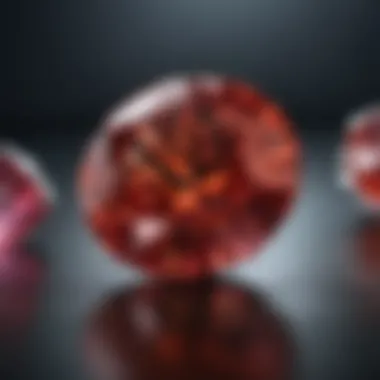
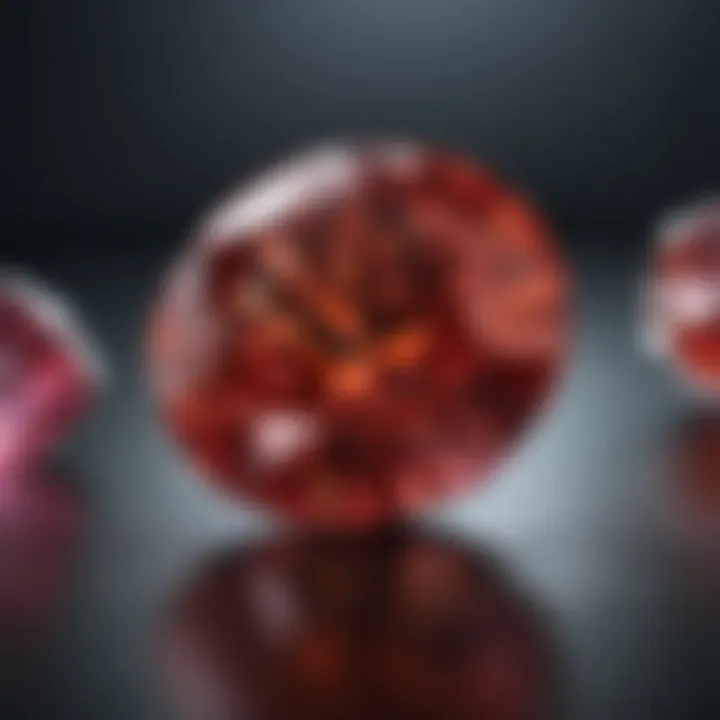
Intro
The exploration of birthstones extends beyond mere decoration. Each stone carries profound historical, cultural, and personal significance, offering insight into ancient beliefs and modern practices. In this article, we will focus on the birthstone of individuals born on December 27. Understanding this birthstone involves examining its unique characteristics, historical significance, and the myths that have surrounded it through the ages.
Gemstone Overview
Definition and Characteristics
The birthstone for December is commonly recognized as turquoise. This mineral is classified as a hydrous phosphate of copper and aluminum. Turquoise exhibits a distinct blue-green hue, which varies in intensity and brightness. Its unique coloration is a result of the presence of copper and iron within its structure, making it a favorite among artisans and gem collectors alike.
Turquoise is opaque and generally has a waxy to sub-vitreous luster. The stone can also showcase patterns such as matrix lines, which are often regarded as enhancing its beauty. Its hardness is rated between 5.0 and 6.0 on the Mohs scale, which indicates it is relatively soft compared to other gemstones. This property makes turquoise ideal for carving but requires careful handling to prevent scratches and damage.
Classification of Gemstones
Gemstones can be classified into two primary categories: precious and semi-precious. Turquoise, historically considered a precious stone, falls into the semi-precious category today. This classification stems from its historical prominence and unique beauty, which have made it highly sought after in jewelry design. Turquoise is thus valued both for its aesthetic appeal and its connections to various cultural traditions.
Historical Significance
Ancient Uses and Cultural Importance
Turquoise has a rich history, tracing back over 5,000 years. Ancient civilizations valued the stone for its beauty and believed it possessed protective qualities. For instance, the Egyptians used turquoise in jewelry and burial artifacts, as they thought it provided protection in the afterlife. The indigenous peoples of the Americas also revered turquoise, believing it held healing properties and facilitated communication with the spirit world.
Throughout its history, turquoise has been utilized in various art forms, from intricate jewelry to ceremonial objects. This reflects its importance not only as a decorative element but also as a key component in cultural rituals and beliefs.
Myths and Legends Surrounding Gemstones
Many myths surround turquoise, often linking it to prosperity and protection. It has been said that wearing turquoise can ward off negative energies and bring good fortune. In some cultures, it was believed that the stone changes color based on the health of its wearer. A shift in color was seen as a warning sign, indicating the need for medical attention or self-care.
"Turquoise is more than just a gemstone; it is a talisman of protection and strength that has survived the tests of time."
Modern interpretations of turquoise continue to emphasize these protective qualities. Jewelers incorporate turquoise into their designs, allowing wearers to connect with its historical significance while enhancing their personal adornment.
Preamble to December Birthstones
December is unique in the realm of birthstones, as it boasts a rich variety of gemstones each with their own individual significance. Understanding these birthstones is not just about appreciating their aesthetic value; it also unveils intricate historical, cultural, and metaphysical dimensions. This section aims to provide a foundational understanding of December birthstones, particularly focusing on their roles in jewelry, heritage, and personal expression.
Overview of Birthstones
Birthstones serve as symbolic representations of the months in which individuals are born. Each gem is often imbued with historical and cultural significance. Traditionally, these stones are believed to offer certain benefits or protection to the wearer. The inclusivity of birthstones also allows for personalized choices when it comes to jewelry design and gift-giving, making each piece unique to the individual's story. Examining the cultural backgrounds of these stones is essential to grasp their importance.
For December, three primary gemstones are recognized: Turquoise, Tanzanite, and Zircon. These stones vary not only in appearance but also in their strengths and associations. For instance, where Turquoise might signify tranquility and protection, Tanzanite is frequently linked to spiritual awareness. Engagement with these meanings deepens the appreciation and relevance of birthstones in contemporary contexts.
Significance of December
The date of December 27 holds special significance for individuals born on this day. Each birthdate carries its own energy and connection to the wider attributes of its associated gemstones. In the case of December 27, the focus on Turquoise can be highlighted. Turquoise is often viewed as a stone of communication and emotional balance. It encourages open dialogue, wisdom, and a peaceful demeanor. Meaningfully, those born on this date can consider the implications of wearing such a stone, viewing it not just as an accessory but also as a symbol of their personal journey and values.
This date is not merely a marker in the calendar; it signifies a unique intersection of personality traits, potential challenges, and the attributes of the gemstone that resonates with that date. Such insights can be beneficial when exploring personal connections to jewelry and the deeper meanings behind the adornments worn.
The Gemstone of December
The gemstone associated with December 27 holds significant importance not only in the realm of astrology but also in jewelry design and personal symbolism. These birthstones are known for their unique properties, aesthetics, and cultural implications. Individuals born on this date may seek these stones for personal use or as gifts that embody heartfelt sentiments. The primary focus of December's birthstones—Turquoise, Tanzanite, and Zircon—each offer distinct attributes which can appeal to collectors, enthusiasts, and jewelry designers alike.
Primary Birthstone: Turquoise
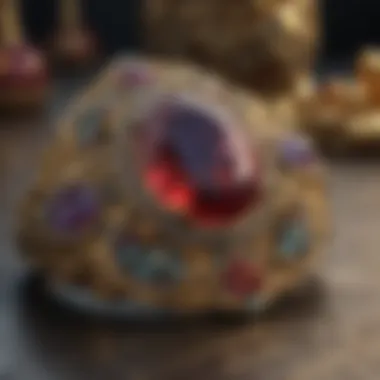
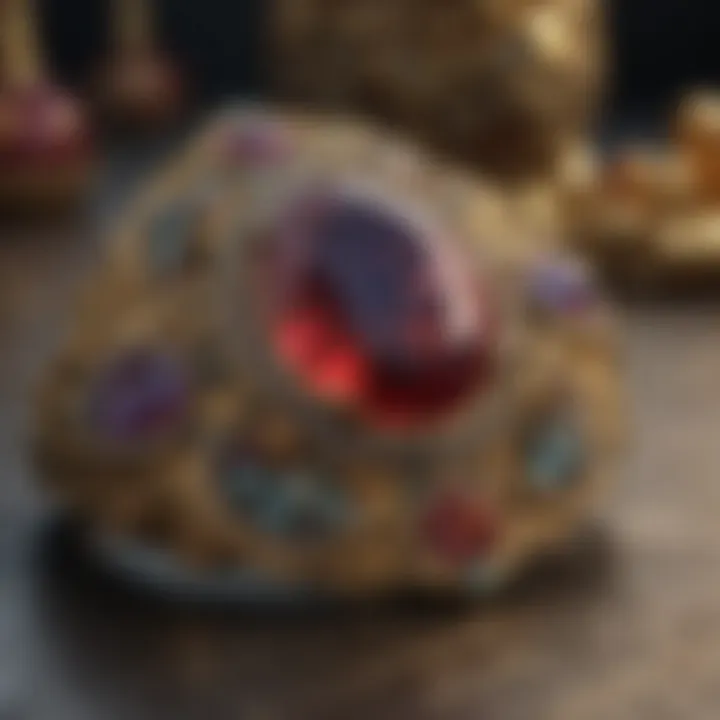
Turquoise is revered for its captivating blue hues, which range from vibrant blue to a softer, greenish-blue. This stone is known for its opaque appearance, and it is often polished to achieve a shiny finish. Turquoise has been valued for thousands of years; its historical context includes use in ancient jewelry and ceremonial artifacts. Beyond aesthetics, turquoise is commonly associated with protection and healing. It is thought to foster communication, wisdom, and tranquility.
Turquoise is also notable for its cultural significance. Many Native American tribes held it sacred, and it was believed to connect the heavens and the earth. For those who appreciate gemstones not just for their beauty, but also for their historical roots, turquoise remains an enduring choice.
Alternate Birthstone: Tanzanite
Discovered in the 1960s, Tanzanite quickly became a sought-after gemstone due to its striking, pleochroic nature. The stone displays different colors when viewed from different angles—often showing blue, violet, and burgundy shades. This chromatic versatility adds to its intrigue. Tanzanite is predominantly sourced from Tanzania, which enhances its market value as being one of the rarest gemstones found today.
From a metaphysical perspective, tanzanite is associated with spiritual awakening. It is believed to enhance intuition and promote self-expression. Gemstone collectors may appreciate tanzanite not only for its visual appeal but also for the deeper connections it promises to facilitate.
Another Alternate: Zircon
Zircon is often mistaken for diamond due to its brilliance and fire. Available in various colors—ranging from colorless to blue, green, and red—zircon boasts a distinct crystalline structure. Unlike synthetic stones, natural zircon has a long history of being used in jewelry, dating back to the Middle Ages.
In addition to its beauty, zircon is known for its durability. It registers between 6 to 7.5 on the Mohs hardness scale, making it suitable for various types of jewelry. People often relate zircon to fostering confidence and authenticity, further amplifying its appeal to those who seek personal growth through their gemstone choices.
Notably, zircon is also valued in the gemstone market for its investment potential. As interest in ethically sourced and unique stones continues to grow, collectors may find zircon to be a wise addition to their portfolios.
"Each December gemstone possesses unique qualities, allowing individuals to connect with them on multiple levels."
In summary, the gemstones associated with December 27—Turquoise, Tanzanite, and Zircon—each represent a blend of history, aesthetic, and metaphysical properties. Understanding these stones encourages deeper appreciation for their significance in personal adornment and cultural context.
Physical Properties of December Birthstones
The physical properties of the December birthstones are crucial to understand their overall appeal and value in the gemstone market. These characteristics play a significant role in determining their desirability for jewelry and collectible purposes. Knowing the chemical composition, color variations, hardness, and durability provides insight into how these stones interact with light, withstand wear, and how they may react to various environmental factors. Such a comprehensive understanding benefits gemstone enthusiasts, collectors, and jewelry designers alike, ensuring informed decisions when selecting or working with these gems.
Chemical Composition
The chemical composition of the December birthstones varies significantly among the primary and alternate stones, namely Turquoise, Tanzanite, and Zircon.
- Turquoise: This gemstone is primarily composed of hydrated copper and aluminum phosphate, represented chemically as CuAl6(PO4)4(OH)8·4O. This unique structure gives Turquoise its striking blue to green color, characterized by its opaque appearance and intricate matrix patterns.
- Tanzanite: Known for its vibrant hues, Tanzanite is a variety of the mineral zoisite and is chemically noted as Ca2Al3(SiO4)(Si2O7)O(OH). The presence of vanadium or chromium ions contributes to its renowned blue and violet shades.
- Zircon: Composed of zirconium silicate, with the chemical formula ZrSiO4, Zircon displays a remarkable range of colors from colorless to various shades. Its complex crystal structure promotes iridescence, making it highly valuable in the gemstone market.
Color Variations and Significance
Color plays an essential role in defining the identity of December birthstones. Each stone showcases unique variations that not only influence aesthetics but also carry cultural significance.
- Turquoise: Typically found in shades of blue and green, Turquoise is often associated with tranquility and protection. Its variations can be attributed to the presence of iron and copper, which influence its final color.
- Tanzanite: This gemstone exhibits a fascinating trichroism, meaning it can show three different colors when viewed from different angles—blue, violet, and burgundy. The intensity of these colors often determines the stone's value, with the richest blues being the most sought after.
- Zircon: The color spectrum of Zircon can range from clear to yellow, red, and green. The blue varieties are particularly popular, often misleadingly marketed as synthetic alternatives to diamonds. Color influences both the market value and symbolic meanings attributed to this stone—for instance, blue Zircon can signify purity and peace.
Hardness and Durability
Understanding the hardness and durability of December birthstones is vital for their applications in jewelry. The Mohs scale of mineral hardness serves as a systematic way to gauge their resilience.
- Turquoise: Scoring between 5 and 6 on the Mohs scale, Turquoise is relatively softer than many gemstones. This softness necessitates careful handling and thoughtful design to prevent scratches and damage.
- Tanzanite: It ranks around 6 to 7 on the Mohs scale, indicating moderate hardness. While Tanzanite can be used in jewelry, it is sensitive to impacts and should be cared for to avoid chipping.
- Zircon: With a Mohs hardness ranging from 6 to 7.5, Zircon is relatively durable, making it suitable for various types of jewelry. Its strength, combined with brilliance and fire similar to diamonds, contributes to its allure among collectors.
"The physical properties of gemstones not only influence their market value but also affect how they are perceived culturally and personally. Understanding these aspects empowers consumers and designers alike to make informed choices."
In summary, the physical properties of December birthstones amount to their chemical make-up, color variations, and hardness. This knowledge forms the foundation for appreciating their significance in both historical context and present-day markets.
Historical Context of December Birthstones
The historical context of December birthstones reveals the intricate connections between these gemstones and the cultures that revered them. Understanding this context provides insights into the significance attached to each stone. The importance of birthstones, particularly turquoise, tanzanite, and zircon, has evolved over time. Each stone serves as a symbol of identity, heritage, and even healing. As we explore these themes, we will see how they contribute to our contemporary understanding of birthstones.
Cultural Significance in Ancient Civilizations
From ancient times, civilizations placed immense value on gemstones. Turquoise, for example, was treasured by various cultures, including the Egyptians and Native Americans. The Egyptians considered turquoise a symbol of protection and healing. They adorned tombs with this stone, believing it would accompany the deceased into the afterlife. Similarly, Native American tribes associated it with the sky and water, using it in rituals and ceremonies.
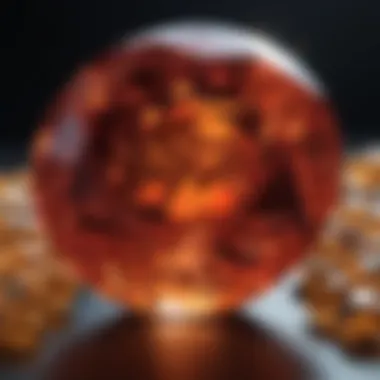
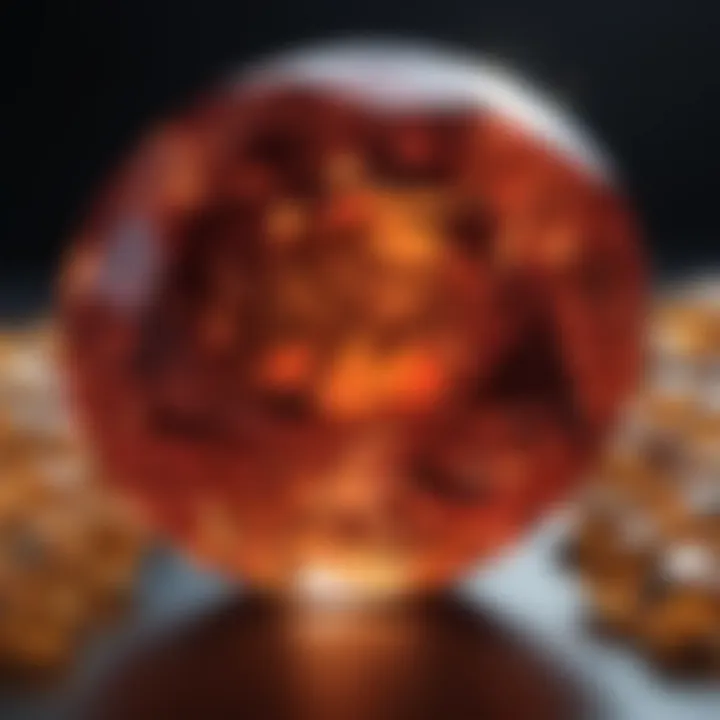
Tanzanite, a more modern addition to the list of December birthstones, was discovered in the late 1960s in Tanzania. Its deep blue-violet color was quickly embraced by jewelers and collectors alike. While ancient cultures did not know it, tanzanite is now celebrated for its unique beauty and rarity.
Zircon also has roots in ancient history. Though often confused with cubic zirconia, its natural counterpart has been used in jewelry since biblical times. Ancient civilizations believed that zircon could promote wisdom and honor. Its significance is reflected in old texts that link it to various mythologies.
Symbolism Through the Ages
The symbolism of December birthstones has shifted but remains deeply ingrained in cultural narratives. Turquoise has consistently symbolized tranquility and protection. In modern gemology, it is often associated with healing properties that are highly regarded in holistic practices. It has been said that wearing turquoise can aid in communication and emotional well-being.
In contrast, tanzanite symbolizes transformation and spiritual growth. Its discovery in relatively recent history means that its cultural significance is still being formed. It has become a stone of choice for those seeking connection to the spiritual realm, often used in meditation practices.
Zircon, with its diverse color variations, symbolizes purity and virtue. Throughout history, various cultures have assigned meanings to its colors. For instance, blue zircon is thought to inspire calmness, while green zircon promotes strength.
"Each gemstone reflects the era in which it was used, weaving a rich tapestry of cultural beliefs and practices."
These symbols and meanings have not only shaped the stones' value but also their desirability in jewelry. Understanding the historical context allows enthusiasts and collectors to appreciate not just the physical properties of these stones, but the rich stories woven into their existence.
In summary, the historical context of December birthstones showcases their significance across different civilizations. The cultural meanings attributed to turquoise, tanzanite, and zircon continue to evolve. By exploring these gemstones, we recognize that they serve as more than simple adornments; they are carriers of history, emotion, and identity.
Metaphysical Properties of December Birthstones
Metaphysical properties refer to the belief that certain materials possess energies and can influence human experiences. This idea has been prevalent in various cultures throughout history. For those who value gemstones not only for their aesthetic appeal but also for their purported abilities, understanding the metaphysical aspects of December birthstones is essential.
Each gemstone associated with December 27 embodies distinct metaphysical qualities, which can vary from emotional healing to spiritual insight. Recognizing these traits allows enthusiasts to select stones that align with personal intentions, whether they seek protection, clarity, or emotional balance.
Turquoise and Its Healing Qualities
Turquoise is renowned for its healing abilities. It is said to foster serenity and aid in the release of negative energies. This stone is often associated with emotional balance, promoting positive emotional states and stability. Many believe that turquoise can enhance communication, making it a popular choice for those looking to express their feelings more clearly.
Additionally, turquoise is thought to have physical healing properties. It is often linked with soothing ailments connected to the respiratory and immune systems. The stone's calming energy is believed to reduce stress and promote overall well-being.
"Turquoise is not just a gemstone but also a companion for emotional healing and balance."
Tanzanite's Spiritual Attributes
Tanzanite, with its captivating blue-violet hue, is celebrated not just for its beauty but also for its spiritual insights. It is commonly associated with higher consciousness and the elevation of spiritual awareness. Many enthusiasts use tanzanite in meditation practices to enhance their connection to the spiritual realm.
This stone is believed to promote inner strength, helping individuals overcome challenges and embrace change. Its soothing energies are said to facilitate calmness and clarity, making it popular among those seeking to deepen their spiritual experiences. Furthermore, tanzanite is thought to assist in the alignment of the throat chakra, fostering effective communication of one’s true self.
Zircon and Its Energetic Benefits
Zircon, often underrated, holds significant energetic benefits. It is believed to enhance mental clarity and focus. Many users find that wearing or carrying zircon helps combat negative thoughts and promotes a more optimistic outlook. Its grounding qualities are said to attract abundance and success, making it a preferred choice in personal development.
Furthermore, zircon's energies are thought to support emotional healing by facilitating self-discovery. As individuals become more aware of their internal processes, they can cultivate healthier relationships and decisions. This gemstone’s versatility is attractive to collectors and those seeking its metaphysical benefits.
Market Trends and Value of December Birthstones
Understanding the market trends and value of December birthstones is crucial for enthusiasts and collectors alike. These factors dictate not only the desirability of stones like turquoise, tanzanite, and zircon but also their investment potential and resale value. With the gemstone market constantly evolving, staying informed on current trends helps buyers make knowledgeable decisions. This section aims to shine a light on notable aspects influencing the market dynamics of these gems.
Current Market Trends
The market for December birthstones has seen significant changes in recent years.
- Turquoise remains a perennial favorite due to its vibrant colors and historical significance. As more consumers seek authentic, natural stones, the demand for genuine turquoise is on the rise.
- Tanzanite, discovered relatively recently in 1967, has exploded in popularity. Its stunning blue hue captures attention. This gemstone is often marketed for its rarity, which adds to its allure.
- Zircon is also regaining traction. Its ability to mimic more expensive stones, coupled with its affordability, makes it appealing to a broader audience.
Recent online platforms and social media have allowed for increased visibility of these materials, particularly among younger generations. Social media trends often influence consumer preferences, leading to fluctuating interest in specific gemstones.


Factors Influencing Gemstone Value
Several factors contribute to the valuation of December birthstones.
- Quality: The clarity, cut, and overall quality of the stone play a major role. Higher-quality turquoise with fewer imperfections fetches a heftier price.
- Rarity: Tanzanite is considered rarer than diamonds due to its limited geographic location. This rarity heightens its market value.
- Treatment and Enhancement: Many gemstones undergo treatment to improve their appearance. Enhanced stones typically have lower value compared to untreated ones. Buyers should be aware of any treatments the stone has received, as this affects pricing.
- Market Demand: Seasonal trends can also affect gemstone prices. For instance, gemstone jewelry often sees a spike in demand during holiday seasons, potentially inflating values during those times.
Investment Potential and Considerations
Investing in December birthstones can be rewarding but requires careful consideration.
- Long-term appreciation: Some gemstones may appreciate over time, especially those that are limited in availability. Experts suggest that tanzanite could become substantially more valuable as its resources deplete.
- Market volatility: Just like any investment, gemstone values can be volatile. There are periods of high demand followed by drops in interest that can affect resale prices.
- Condition and Documentation: To maintain value, it is crucial to keep gemstones in good condition. Proper documentation, including certificates of authenticity, enhances their marketability.
"Investing in gemstones is not merely about the stone but also about the story and significance behind it. The value often comes from its rarity and the emotions it evokes within its owner."
In summary, understanding the market trends, factors influencing value, and investment potential is essential when exploring December birthstones. This knowledge equips collectors and enthusiasts to navigate the complex landscape of gemstone investments and ensures wise decisions are made in pursuing these exquisite pieces.
Care and Maintenance of December Birthstones
The care and maintenance of December birthstones are crucial for preserving their beauty and intrinsic value. Gemstones like turquoise, tanzanite, and zircon require specific treatment to keep them in optimal condition. Proper care not only enhances their allure but can also extend their lifespan significantly. Understanding the appropriate methods for cleaning, storage, and handling is essential for collectors and enthusiasts alike.
Cleaning and Storage Tips
When it comes to cleaning December birthstones, the approach should be gentle yet effective. Here are some tips for cleaning:
- Use Mild Soap and Water: A solution of warm water and mild soap can safely cleanse most types of stones. Turquoise and tanzanite are particularly sensitive, so avoid harsh chemicals.
- Soft Cloth for Drying: After washing, use a soft, lint-free cloth to gently dry the gemstone. This prevents scratches and maintains its shine.
- Avoid Ultrasonic Cleaners: For delicate stones like tanzanite, ultrasonic cleaners should be avoided as they can cause fractures or damage.
Storage considerations are equally important. Proper storage minimizes exposure to harmful elements.
- Separate Storage: Keep different types of gemstones in separate pouches or compartments. This prevents scratches and damage from rubbing against one another.
- Use a Soft Lined Box: A soft-lined jewelry box is ideal for storing your birthstones safely, protecting them from dust and impact.
Avoiding Common Damages
Preventing damages to December birthstones requires diligence and awareness of their vulnerabilities. Here are common issues and how to avoid them:
- Chemical Sensitivity: Many gemstones react poorly to chemical cleaners. Always ensure any cleaning solution is safe for the specific birthstone type.
- Physical Impact: Keep gemstones away from areas where they can fall or be subjected to hard knocks. Use protective coverings, especially during travel.
- Extreme Temperatures: Sudden temperature changes can cause stones to crack or become dull. Store pieces away from drafts, direct sunlight, or high heat.
Remember: Regular maintenance may include checking for loose settings or signs of wear. Being proactive helps in maintaining their integrity.
Essentially, proper care and maintenance are not just about aesthetics. They are critical for preserving the longevity and value of December birthstones. For any gemstone enthusiast or collector, understanding and implementing these care routines is a sign of respect for these ancient natural wonders.
Epilogue
Concluding this thorough exploration of December 27’s birthstones, it is essential to reflect on the various dimensions covered throughout the article. The importance of the topic lies in the multifaceted nature of gemstones like turquoise, tanzanite, and zircon. Each of these stones not only possesses unique physical characteristics but also holds significant historical and cultural importance. Understanding these aspects enhances appreciation for the gemstones and helps potential buyers and collectors make informed choices.
The key benefits discussed include the physical properties that distinguish each stone, the historical significance that adds depth to their meanings, and the unique metaphysical associations that continue to attract individuals seeking personal connections. Care and maintenance tips provided further ensure that these gems can be enjoyed for generations, highlighting their practical relevance in daily life.
As consumers become more discerning in their choices, being knowledgeable about the elements and care of these stones enriches their purchasing decision. With their fascinating history and timeless appeal, December birthstones can serve as both personal treasures and valuable assets in collections.
"The impact of birthstones goes beyond mere adornment; they symbolize identity, heritage, and personal significance."
Recap of Key Points
In this article, we examined a variety of important elements related to the birthstone of December 27. Here are the key points summarized:
- Primary Birthstones: Turquoise, tanzanite, and zircon each have their unique chemical compositions and attributes.
- Cultural Importance: Ancient civilizations revered these stones for their perceived powers and beauty.
- Physical Properties: Factors such as hardness and color variations contribute to the value of each gemstone.
- Metaphysical Properties: Each stone is associated with specific healing and spiritual benefits that appeal to many.
- Market Trends: Awareness of current trends and factors influencing value can assist in investment decisions concerning these gemstones.
- Care and Maintenance: Proper cleaning and storage techniques are essential in preserving the integrity of these beautiful stones.
Final Thoughts on December Birthstones
Ultimately, the significance of December birthstones extends from mere decoration to a profound connection with history and symbolism. Collectors and enthusiasts will find in turquoise, tanzanite, and zircon not just beautiful stones but also rich narratives that can resonate personally. Keeping abreast of the market dynamics will aid collectors and designers in making strategic decisions around their acquisitions.
As gemstones continue to play a pivotal role in jewelry design and personal adornment, appreciating their multifaceted properties becomes increasingly important. December birthstones stand as symbols of identity, heritage, and individual expression, fostering a personal connection that lasts well beyond the aesthetic.







